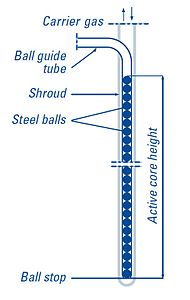Ball measuring system
A ball measuring system (engl. Areoball Measurement System ) is used for cyclical high-resolution measurement of the neutron flux distribution in the reactor core used some series of nuclear power plants. It's part of the core instrumentation.
Layout and function
Vertical lances (holders for measuring instruments) protrude into the core at several points of the core. With the help of a propellant gas, steel balls containing vanadium are transported into the lances. The sphere diameter is about 1 to a few millimeters. So many balls are used per lance that the entire height of the core is covered. The spheres remain in place for a few minutes, are activated by the neutrons and then transported with the propellant to a measurement position outside the core. There, the activity is measured spatially resolved with several radiation detectors. Since the activation depends on the neutron flux prevailing at the measurement location, the distribution of the neutron flux in the core can be determined. The resultingRadionuclide vanadium-52 breaks down into the stable chromium -52 with a half-life of 3.75 minutes ; the balls can therefore be used again after a short cooldown.
The flow distribution determined in this way is used, among other things, to regularly recalibrate the continuously measuring (but equipped with fewer measuring points) neutron measuring systems or to validate their signals. This enables an image of the thermal power distribution in the core to be obtained.
Structure of the measuring probe using the example of the EPR ball measuring system .
| Number of channels (lances) | 40 |
| Ball diameter | 1.7 mm |
| Height accuracy | ≤ 1.5 cm |
| Propellant | nitrogen |
| Exposure time in the core | about 3 min |
| Duration between two measurements | 10 min |
| accuracy | ≤ 1% of the neutron flux |


